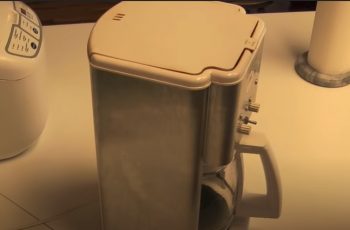The coffee machine is a modern marvel; with only a few grinds of coffee and a little water, you have fresh coffee in minutes. Although we make so much coffee each day, we often don’t give our machines the attention they deserve. Those who love coffee may neglect their coffee machines for weeks, months, and even years at a time.
Without proper maintenance, coffee machines may malfunction or even stop functioning. Calcium deposits in coffee machines can cause coffee to taste awful. Remove those by regularly cleaning your coffee maker.
Learning How To Clean Calcium Buildup In A Coffee Maker
A calcium deposit is a natural byproduct of coffee brewing. Isn’t that dreadful white substance that clogs your coffee maker and causes you to ruin your morning coffee? Typically hard water causes this hard coating, which is made up of calcium, magnesium, lime, and other minerals.
The buildup can become so thick that it may seem that sandpaper or chemicals might be needed to remove it. If you see a chalky white residue in old or less feature-rich coffee makers, it’s time for a descale.
Descale: What Does It Mean?
About 99 percent of coffee is water, so it plays a vital role in producing great coffee.
Minerals such as calcium and magnesium are found in all water, which travels through your coffee maker and, ultimately, form limescale on the heating element.
Mineral buildup in a coffee maker can be removed by decanting it. Hard water is more harmful to coffee equipment because it has a more significant amount of these minerals. It is possible that months of mineral accumulation can exist in a machine because you cannot see the heating components.
Your brewer will slow down over time as calcium and other minerals collect. Lines can become clogged, and water can be restricted.
Several brands of descaling solutions contain acidic chemicals, potent enough to remove mineral deposits from your coffee maker. You can, however, make a DIY descaling solution using everyday household items.
Creating your descaling solution could save you money and give you complete control over what’s inside your coffee maker. Natural descalers are also had a similar effect to commercial ones.
Vinegar
When it comes to homemade cleaning products, vinegar is an excellent cleaning agent. Research has shown that vinegar can sanitize and clean. Since vinegar has high acidity, it is excellent at removing minerals.
Vinegar is very cheap and readily available. This is beneficial since it may take many cycles to remove all of the calcium and other minerals accumulated on your machine.
You can create a solution by mixing 1/3 vinegar with 2/3 water.
Citric Acid
Citric acid also has a relatively low pH, making it an excellent mineral remover. It smells nice and doesn’t remain after it’s been rinsed away. This makes citrus acid worthy for decaling. Usually, after using a cleaning solution, it leaves a chemical scent and taste, but citric acid will not.
Aside from being cheap, it’s easy to find. Almost every grocery store sells citric acid pellets.
You will likely have to do more cycles to achieve the same results because it’s less acidic than commercial cleaners and vinegar.
Mix a tablespoon of citric acid pellets into a gallon of water.
Baking Soda
Baking soda will help clear your coffee maker of any stains or mineral buildups.
While baking soda is effective for cleaning, it may not work well for descaling. Several runs of this solution will be needed to descale your machine thoroughly.
Your machine will shine clean and will not leave any smell or flavor behind when using baking soda.
Mix a teaspoon of baking soda into about a liter of warm water until it becomes homogeneous.
Lemon Juice
Lemon juice provides one of the most effective and delightfully smelling ways to descale your coffee maker.
Despite its acidity, lemon juice is all-natural, so you will not have to worry about cleaning your coffee maker with it. Make sure you run the machine with water to remove the taste.
For the solution, mix 1/3 lemon juice and 2/3 water.
How to Remove Calcium And Other Mineral Deposits From a Coffee Maker
1) Clean the coffee filter, then brew an entire pot of any of the above mixtures.
2) Turn off the coffee maker halfway through the brewing cycle and allow the solution to sit for an hour.
3) Restart the coffeemaker to complete the brewing process.
4) Then, add two cycles of clean water to the brewing cycle and replace the coffee filter.
Conclusion
When you have to get up with the sun the next time and see that your coffee maker’s red indicator light is on, indicating that it’s time to clean it, you may already know what method to use. You may be able to restore your coffee machine to its former glory with a few simple steps. One can easily Clean Calcium Buildup In A Coffee Maker without difficulty!


